power steering fluid JEEP COMMANDER 2008 1.G Owners Manual
[x] Cancel search | Manufacturer: JEEP, Model Year: 2008, Model line: COMMANDER, Model: JEEP COMMANDER 2008 1.GPages: 478, PDF Size: 6.97 MB
Page 305 of 478
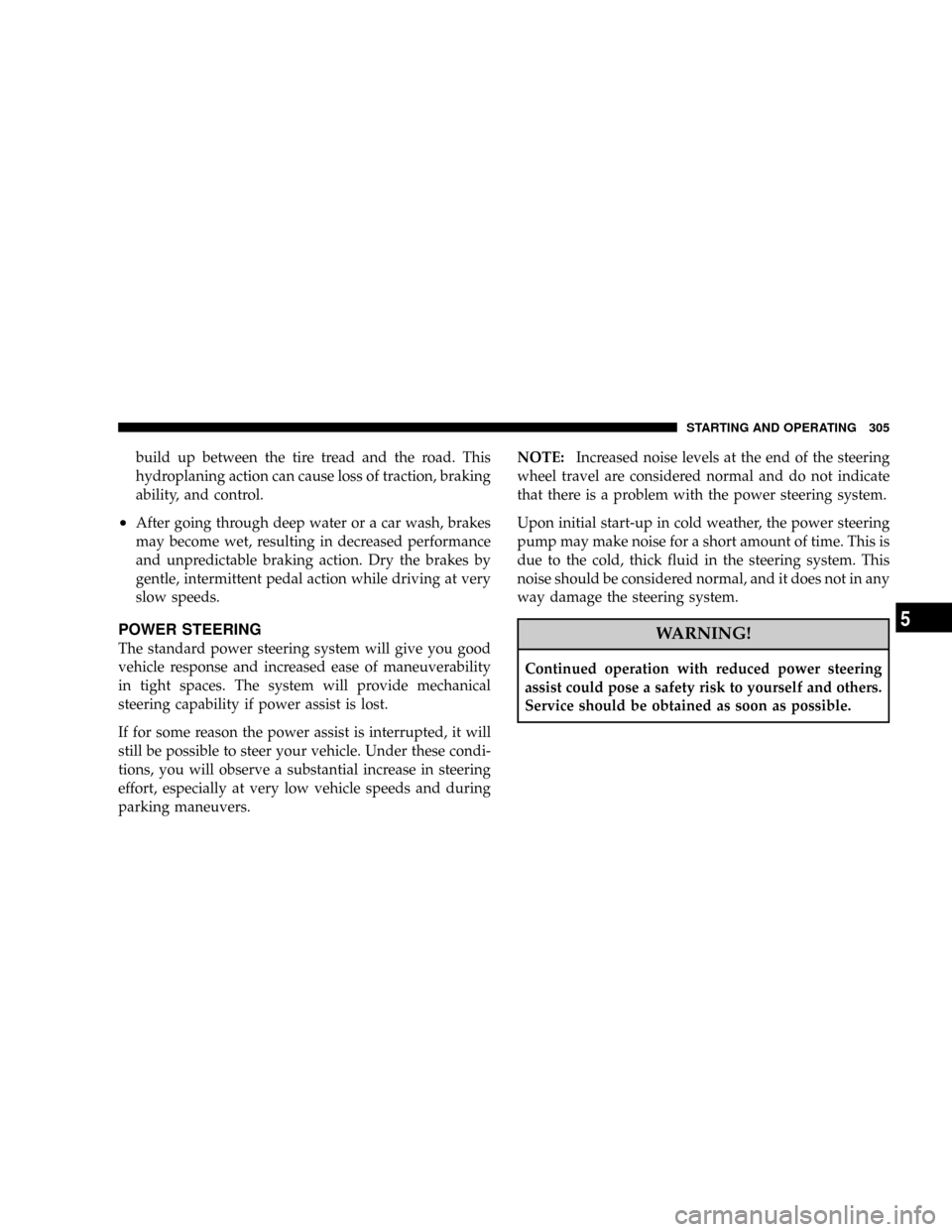
build up between the tire tread and the road. This
hydroplaning action can cause loss of traction, braking
ability, and control.
²After going through deep water or a car wash, brakes
may become wet, resulting in decreased performance
and unpredictable braking action. Dry the brakes by
gentle, intermittent pedal action while driving at very
slow speeds.
POWER STEERING
The standard power steering system will give you good
vehicle response and increased ease of maneuverability
in tight spaces. The system will provide mechanical
steering capability if power assist is lost.
If for some reason the power assist is interrupted, it will
still be possible to steer your vehicle. Under these condi-
tions, you will observe a substantial increase in steering
effort, especially at very low vehicle speeds and during
parking maneuvers.NOTE:Increased noise levels at the end of the steering
wheel travel are considered normal and do not indicate
that there is a problem with the power steering system.
Upon initial start-up in cold weather, the power steering
pump may make noise for a short amount of time. This is
due to the cold, thick fluid in the steering system. This
noise should be considered normal, and it does not in any
way damage the steering system.WARNING!
Continued operation with reduced power steering
assist could pose a safety risk to yourself and others.
Service should be obtained as soon as possible.
STARTING AND OPERATING 305
5
Page 306 of 478
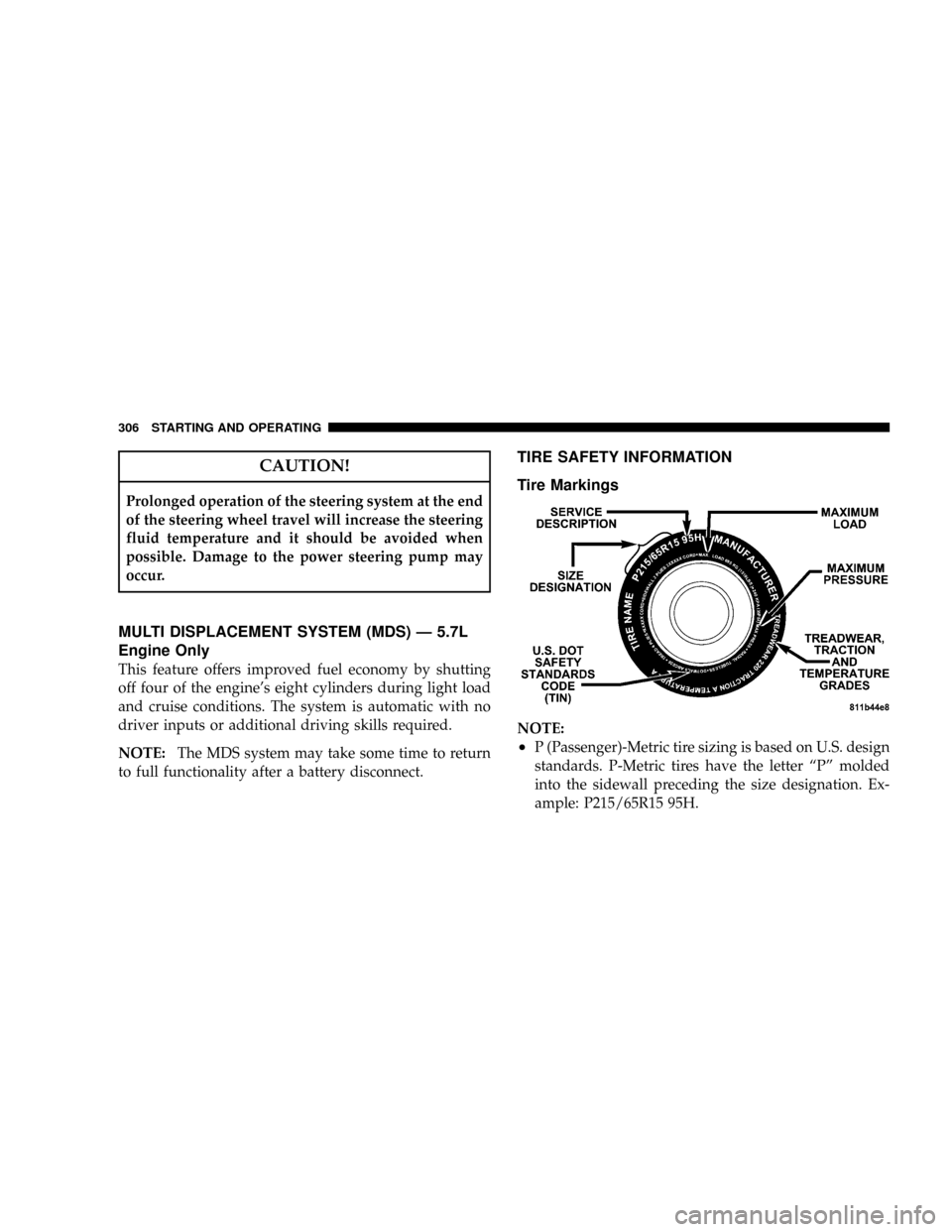
CAUTION!
Prolonged operation of the steering system at the end
of the steering wheel travel will increase the steering
fluid temperature and it should be avoided when
possible. Damage to the power steering pump may
occur.
MULTI DISPLACEMENT SYSTEM (MDS) Ð 5.7L
Engine Only
This feature offers improved fuel economy by shutting
off four of the engine's eight cylinders during light load
and cruise conditions. The system is automatic with no
driver inputs or additional driving skills required.
NOTE:The MDS system may take some time to return
to full functionality after a battery disconnect.
TIRE SAFETY INFORMATION
Tire Markings
NOTE:
²P (Passenger)-Metric tire sizing is based on U.S. design
standards. P-Metric tires have the letter ªPº molded
into the sidewall preceding the size designation. Ex-
ample: P215/65R15 95H.
306 STARTING AND OPERATING
Page 380 of 478

NAir Conditioner Maintenance.............397
NPower Steering Fluid Check..............398
NBody Lubrication.....................399
NWindshield Wiper Blades................400
NWindshield Washers Ð Front And Rear.....400
NExhaust System......................401
NCooling System.......................401
NHoses And Vacuum/Vapor Harnesses.......406
NFuel System Connections................407
NBrake System........................407
NFront/Rear Axle Fluid..................410
NTransfer Case........................410
NAutomatic Transmission................411NMaintenance After Off-Road Driving........414
NAppearance Care And Protection From
Corrosion...........................415
mFuse Panel...........................419
NInterior Fuses........................419
NUnderhood Fuses (Power Distribution
Center)............................422
NUnderhood Fuses (Integrated Power
Module)............................425
mVehicle Storage........................426
mReplacement Bulbs......................427
mBulb Replacement......................428
NHead Light..........................428
NFront Turn Signal.....................430
380 MAINTAINING YOUR VEHICLE
Page 398 of 478
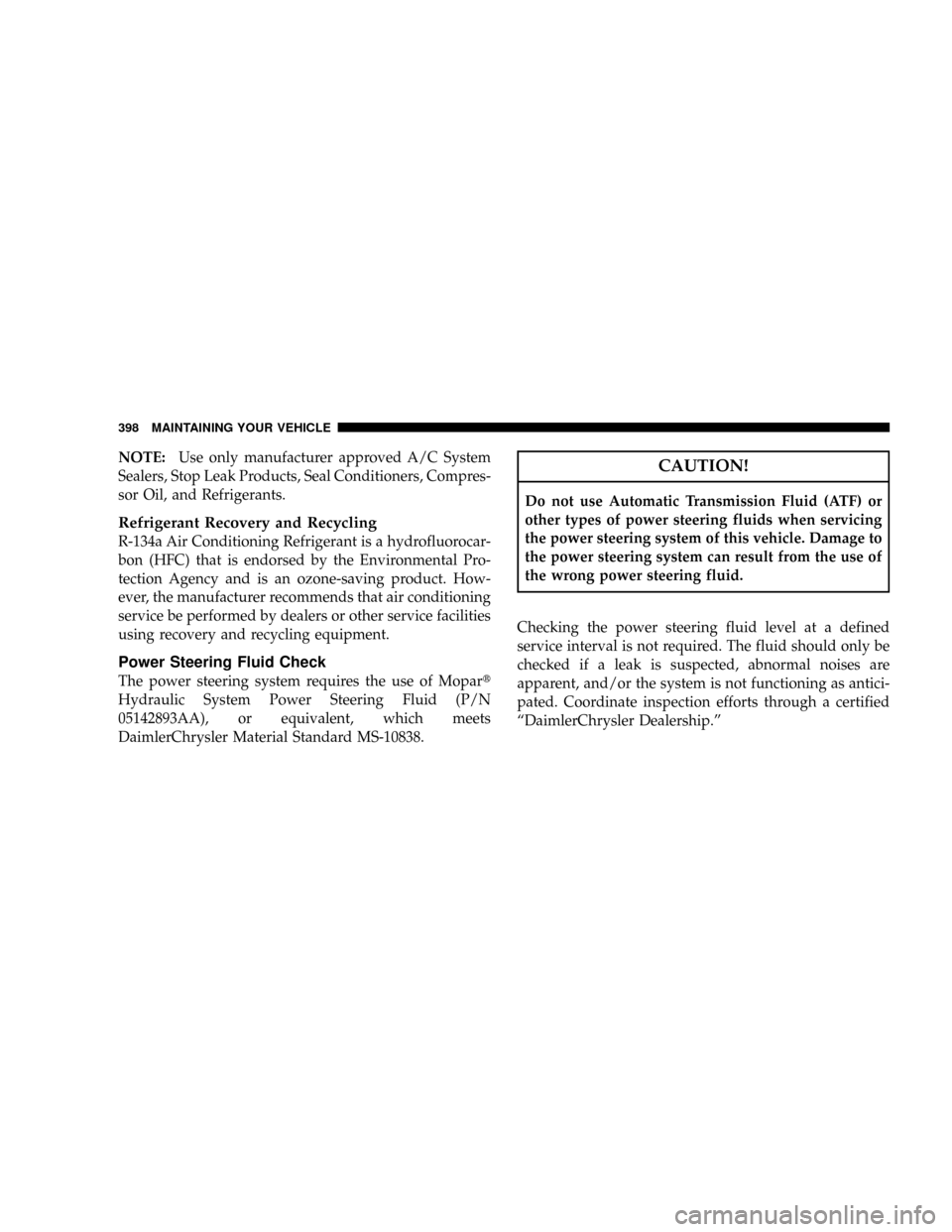
NOTE:Use only manufacturer approved A/C System
Sealers, Stop Leak Products, Seal Conditioners, Compres-
sor Oil, and Refrigerants.
Refrigerant Recovery and Recycling
R-134a Air Conditioning Refrigerant is a hydrofluorocar-
bon (HFC) that is endorsed by the Environmental Pro-
tection Agency and is an ozone-saving product. How-
ever, the manufacturer recommends that air conditioning
service be performed by dealers or other service facilities
using recovery and recycling equipment.
Power Steering Fluid Check
The power steering system requires the use of Mopart
Hydraulic System Power Steering Fluid (P/N
05142893AA), or equivalent, which meets
DaimlerChrysler Material Standard MS-10838.
CAUTION!
Do not use Automatic Transmission Fluid (ATF) or
other types of power steering fluids when servicing
the power steering system of this vehicle. Damage to
the power steering system can result from the use of
the wrong power steering fluid.
Checking the power steering fluid level at a defined
service interval is not required. The fluid should only be
checked if a leak is suspected, abnormal noises are
apparent, and/or the system is not functioning as antici-
pated. Coordinate inspection efforts through a certified
ªDaimlerChrysler Dealership.º
398 MAINTAINING YOUR VEHICLE
Page 399 of 478
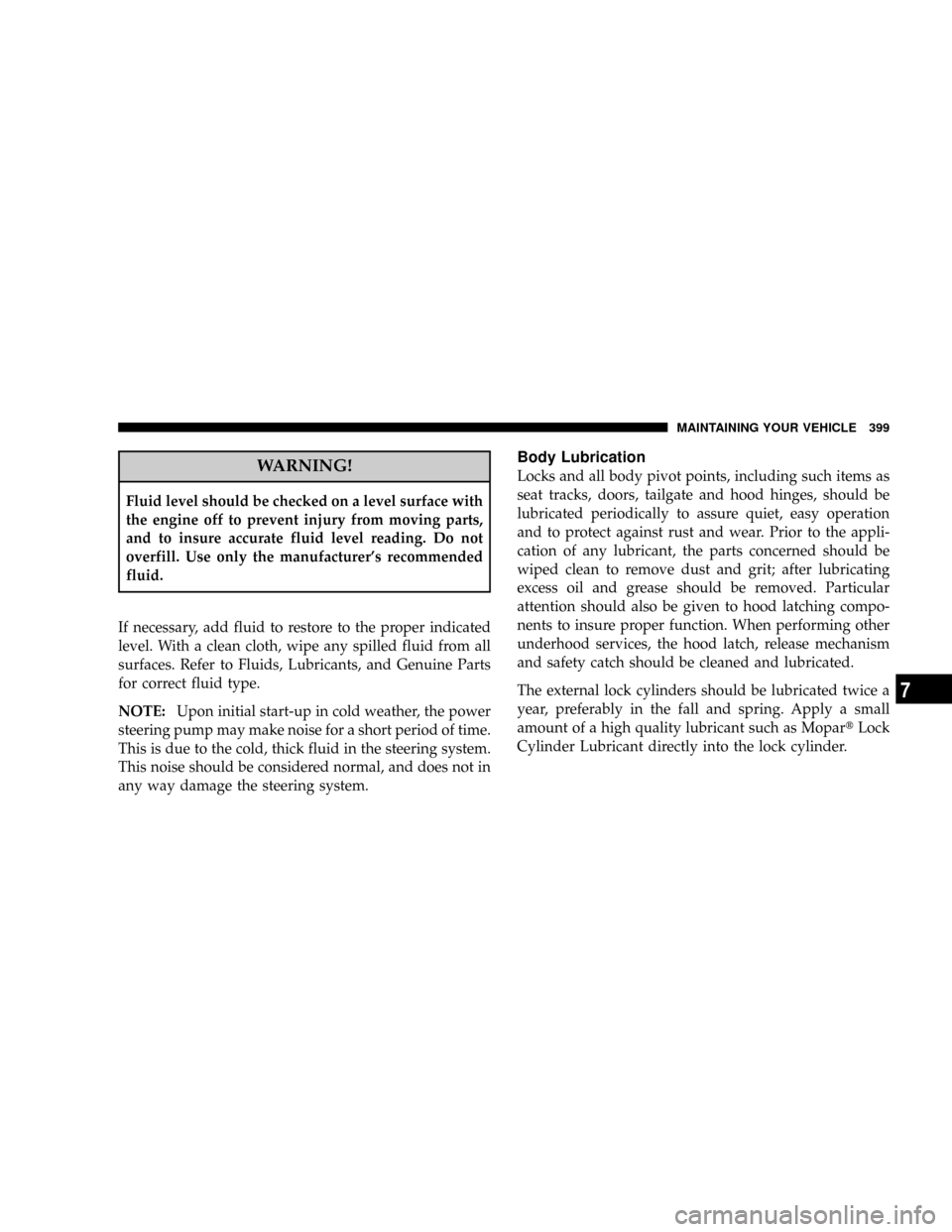
WARNING!
Fluid level should be checked on a level surface with
the engine off to prevent injury from moving parts,
and to insure accurate fluid level reading. Do not
overfill. Use only the manufacturer's recommended
fluid.
If necessary, add fluid to restore to the proper indicated
level. With a clean cloth, wipe any spilled fluid from all
surfaces. Refer to Fluids, Lubricants, and Genuine Parts
for correct fluid type.
NOTE:Upon initial start-up in cold weather, the power
steering pump may make noise for a short period of time.
This is due to the cold, thick fluid in the steering system.
This noise should be considered normal, and does not in
any way damage the steering system.
Body Lubrication
Locks and all body pivot points, including such items as
seat tracks, doors, tailgate and hood hinges, should be
lubricated periodically to assure quiet, easy operation
and to protect against rust and wear. Prior to the appli-
cation of any lubricant, the parts concerned should be
wiped clean to remove dust and grit; after lubricating
excess oil and grease should be removed. Particular
attention should also be given to hood latching compo-
nents to insure proper function. When performing other
underhood services, the hood latch, release mechanism
and safety catch should be cleaned and lubricated.
The external lock cylinders should be lubricated twice a
year, preferably in the fall and spring. Apply a small
amount of a high quality lubricant such as MopartLock
Cylinder Lubricant directly into the lock cylinder.
MAINTAINING YOUR VEHICLE 399
7
Page 408 of 478
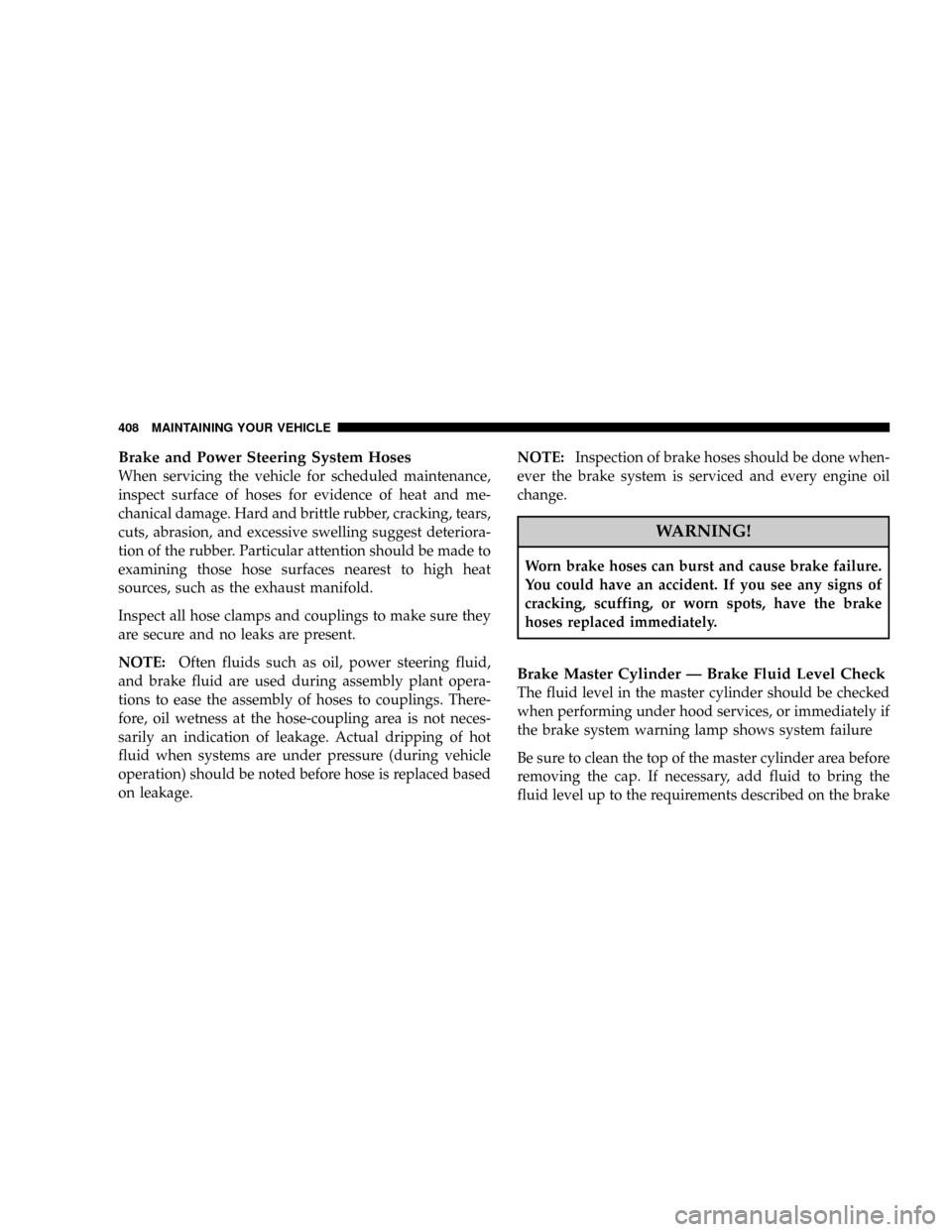
Brake and Power Steering System Hoses
When servicing the vehicle for scheduled maintenance,
inspect surface of hoses for evidence of heat and me-
chanical damage. Hard and brittle rubber, cracking, tears,
cuts, abrasion, and excessive swelling suggest deteriora-
tion of the rubber. Particular attention should be made to
examining those hose surfaces nearest to high heat
sources, such as the exhaust manifold.
Inspect all hose clamps and couplings to make sure they
are secure and no leaks are present.
NOTE:Often fluids such as oil, power steering fluid,
and brake fluid are used during assembly plant opera-
tions to ease the assembly of hoses to couplings. There-
fore, oil wetness at the hose-coupling area is not neces-
sarily an indication of leakage. Actual dripping of hot
fluid when systems are under pressure (during vehicle
operation) should be noted before hose is replaced based
on leakage.NOTE:Inspection of brake hoses should be done when-
ever the brake system is serviced and every engine oil
change.
WARNING!
Worn brake hoses can burst and cause brake failure.
You could have an accident. If you see any signs of
cracking, scuffing, or worn spots, have the brake
hoses replaced immediately.
Brake Master Cylinder Ð Brake Fluid Level Check
The fluid level in the master cylinder should be checked
when performing under hood services, or immediately if
the brake system warning lamp shows system failure
Be sure to clean the top of the master cylinder area before
removing the cap. If necessary, add fluid to bring the
fluid level up to the requirements described on the brake
408 MAINTAINING YOUR VEHICLE
Page 437 of 478
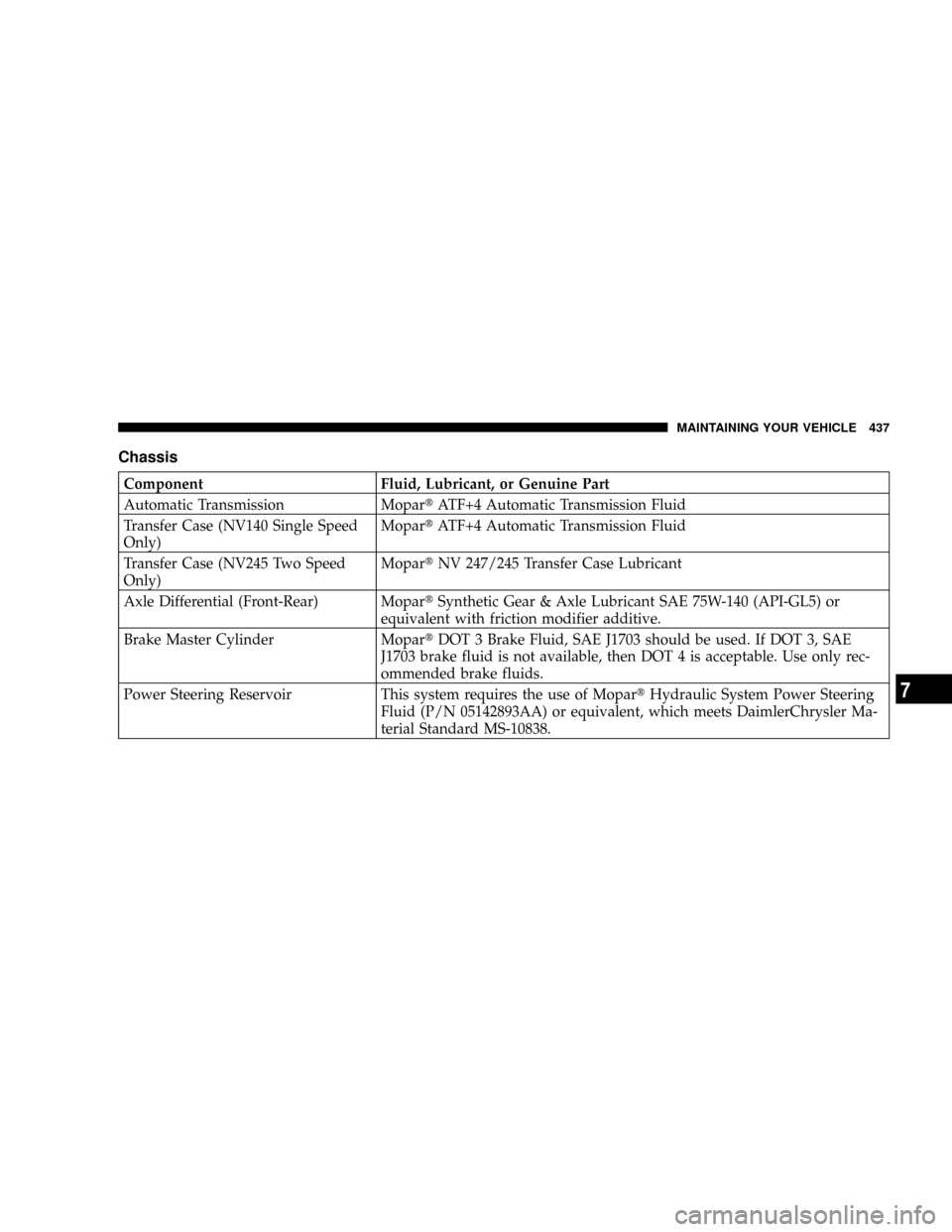
Chassis
Component Fluid, Lubricant, or Genuine Part
Automatic Transmission MopartATF+4 Automatic Transmission Fluid
Transfer Case (NV140 Single Speed
Only)MopartATF+4 Automatic Transmission Fluid
Transfer Case (NV245 Two Speed
Only)MopartNV 247/245 Transfer Case Lubricant
Axle Differential (Front-Rear) MopartSynthetic Gear & Axle Lubricant SAE 75W-140 (API-GL5) or
equivalent with friction modifier additive.
Brake Master Cylinder MopartDOT 3 Brake Fluid, SAE J1703 should be used. If DOT 3, SAE
J1703 brake fluid is not available, then DOT 4 is acceptable. Use only rec-
ommended brake fluids.
Power Steering Reservoir This system requires the use of MopartHydraulic System Power Steering
Fluid (P/N 05142893AA) or equivalent, which meets DaimlerChrysler Ma-
terial Standard MS-10838.
MAINTAINING YOUR VEHICLE 437
7
Page 441 of 478
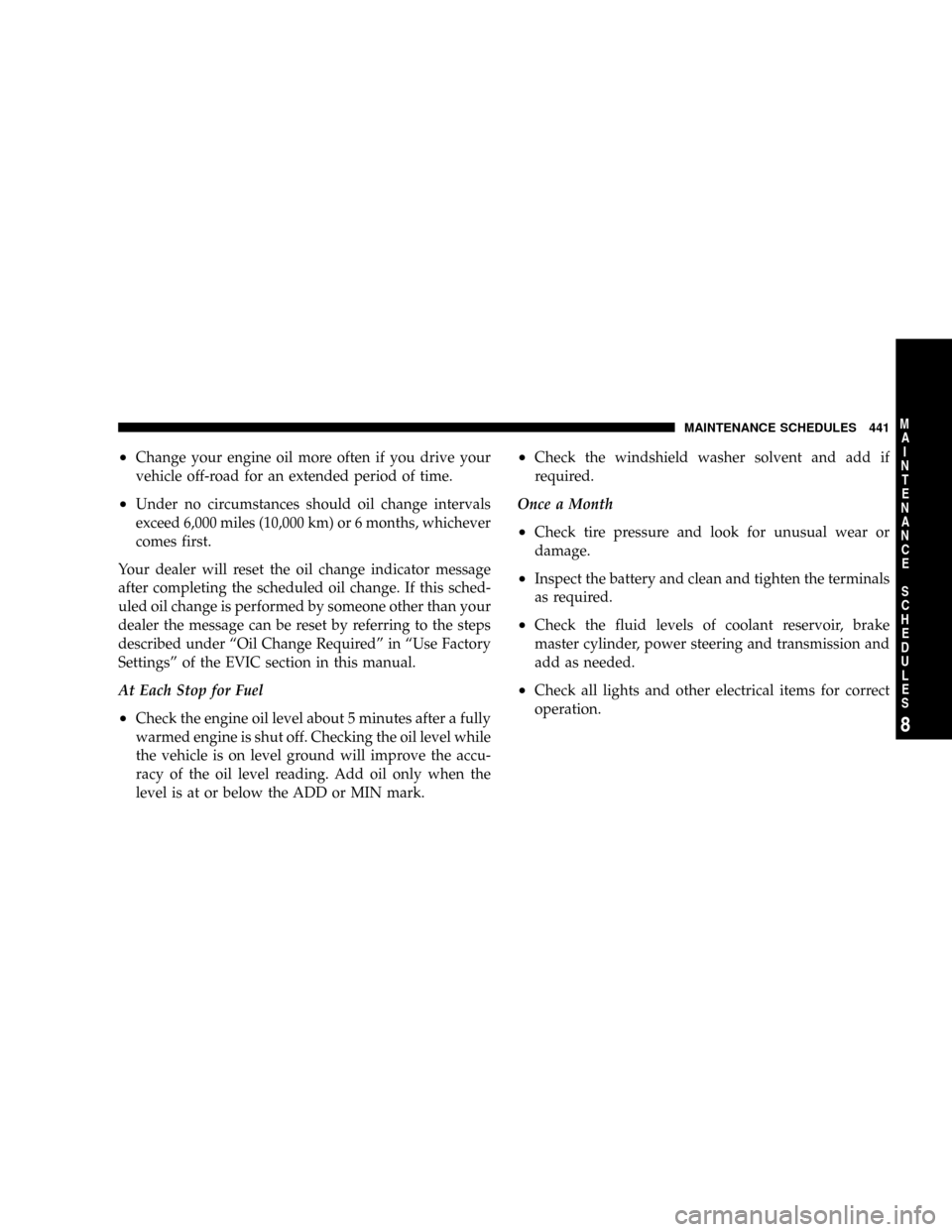
²Change your engine oil more often if you drive your
vehicle off-road for an extended period of time.
²Under no circumstances should oil change intervals
exceed 6,000 miles (10,000 km) or 6 months, whichever
comes first.
Your dealer will reset the oil change indicator message
after completing the scheduled oil change. If this sched-
uled oil change is performed by someone other than your
dealer the message can be reset by referring to the steps
described under ªOil Change Requiredº in ªUse Factory
Settingsº of the EVIC section in this manual.
At Each Stop for Fuel
²Check the engine oil level about 5 minutes after a fully
warmed engine is shut off. Checking the oil level while
the vehicle is on level ground will improve the accu-
racy of the oil level reading. Add oil only when the
level is at or below the ADD or MIN mark.
²Check the windshield washer solvent and add if
required.
Once a Month
²Check tire pressure and look for unusual wear or
damage.
²Inspect the battery and clean and tighten the terminals
as required.
²Check the fluid levels of coolant reservoir, brake
master cylinder, power steering and transmission and
add as needed.
²Check all lights and other electrical items for correct
operation.
MAINTENANCE SCHEDULES 441
8
M
A
I
N
T
E
N
A
N
C
E
S
C
H
E
D
U
L
E
S
Page 461 of 478

Pressure Cap......................... 404
Radiator Cap......................... 404
Selection of Coolant (Antifreeze).........402,435
Courtesy Lights......................... 130
Crankcase Emission Control System.......... 395
Cruise Light........................... 193
Cup Holder............................ 172
Customer Assistance..................... 448
Data Recorder, Event...................... 58
Daytime Running Lights................... 128
Dealer Service.......................... 388
Defroster, Rear Window................... 177
Defroster, Windshield................71,258,265
Diagnostic System, Onboard................ 385
Digital Video Disc (DVD) Player............. 239
Dimmer Switch, Headlight................. 129
Dipsticks
Automatic Transmission................. 412Oil (Engine).......................... 389
Power Steering........................ 398
Disabled Vehicle Towing................... 378
Disposal
Antifreeze (Engine Coolant)............... 405
Engine Oil........................... 391
Used Engine Fluids..................... 391
Door Locks............................. 28
Door Locks, Automatic.................... 29
Door Opener, Garage..................... 159
Drive Belts............................ 392
Driving............................... 296
Off-Pavement......................... 296
Off-Road............................ 296
DVD Player (Video Entertainment System)...... 253
E-85 Fuel............................. 337
Electric Remote Mirrors.................... 80
Electrical Outlet, Auxiliary (Power Outlet)...... 169
INDEX 461
10
Page 463 of 478

Starting............................. 277
Temperature Gauge..................... 191
Engine Oil Viscosity...................... 390
Engine Oil Viscosity Chart................. 390
Enhanced Accident Response Feature.......... 56
Entry System, Illuminated.................. 21
Event Data Recorder...................... 58
Exhaust Gas Caution.................38,70,337
Exhaust System......................... 401
Extender, Seat Belt........................ 48
Exterior Finish Care...................... 415
Filters
Air Cleaner.......................... 393
Engine Oil........................... 391
Engine Oil Disposal.................... 391
Finish Care............................ 415
Flashers.............................. 366
Hazard Warning....................... 366Turn Signal.....................187,430,432
Flexible Fuel Vehicles
Cruising Range........................ 340
Engine Oil........................... 340
Fuel Requirements..................337,339
Replacement Parts..................... 340
Starting............................. 340
Flipper Glass, Liftgate..................... 35
Flooded Engine Starting................... 279
Fluid Capacities......................... 435
Fluid Leaks............................. 72
Fluid Level Checks
Automatic Transmission............... 411,412
Engine Oil........................... 389
Power Steering........................ 398
Fluids, Lubricants and Genuine Parts.......... 436
Fog Light Service........................ 431
Fog Lights.......................128,194,431
Fold and Tumble Rear Seat................. 113
INDEX 463
10